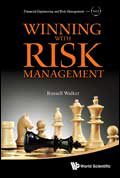Winning with Risk Management by Russell Walker. World Scientific Publishing, 2013. 234 + xxii pages. US$68.00.

Russell Walker's recent book, Winning with Risk Management, offers lessons for chemical engineers as we deal with risks on a daily basis. Examples of properly managed uncertainties as well as case studies exemplifying disasters are provided to strengthen Walker's models.
Origins of risk management began as a concept associated with shippers bearing the "risk" of ocean-going cargo lost in transit. Aversion to risk resulted in the rise of Lloyds of London offering insurance on such shipping losses.
Risk can be defined along many lines. First, explicit risk means that the presence of the risk is not a surprise. Implicit risk, on the other hand, is one that is not realized a priori and may be unknown due to a series of linked events. Often in hazard analyses at petrochemical plants, we will identify "multiple contingency" events that can result in unknown outcomes due to a series of linked events.
Walker also categorizes risks on a scale ranging from finite to infinite. Occurrence of finite risks may be difficult to assess, but the maximum loss is limited. An example of this is a loan. A bank may not know how many loans will go bad, but they can calculate the maximum dollar loss of the amount lent.
Infinite risks are defined to be implicit to the business model. Walker gives two examples familiar to all chemical engineers: the Exxon Valdez oil spill and the Deepwater Horizon incident. The very nature of drilling brings an infinite risk (as defined as part of the cost of participating in a given industry) of spills and environmental damage.
Particularly important to engineers and technicians are operational risks (pg. 22). These risks arise from internal processes, systems, people, and external events. Walker also details the traditional decisions associated with risk management (pg. 31):
- Avoidance,
- Transfer,
- Acceptance,
- Mitigation, or
- Exit the business.
Chapters 4 through 8 yield excellent case studies and lessons on risk management. For example, a risk of single-source supply in the cell-phone industry led to delayed market launches and financial setbacks for Ericsson. Chapter 5 describes a highly relevant credit risk when hackers were able to steal credit card information from a major retailer. Other chapters detail risks that went undetected by major financial firms leading to the economic collapse of 2007-8.
Chemical engineers will be particularly interested in Chapter 10 describing the history (up to 2013) of the Deepwater Horizon incident. Walker offers data supporting the impact of culture at BP during the Texas City explosion. The warning for all chemical engineers is not to become complacent and not to think "it can't happen here."
Chapter 13 concludes Winning with Risk Management by providing focal points to improve communication and risk identification. These include risk metrics, monitoring competitors, and aligning risk tolerance (risk taking) with the firm's strategic goals.
While I expected a book on risk management to be dry and boring, I was pleasantly surprised to find Walker's style engaging. Of special interest are the many relevant case studies that help the reader to identify decisions that led to catastrophe or to success. Winning with Risk Management is highly recommended for any engineer, and especially for professionals with risk analysis responsibilities.
What processes or systems do you use to understand and manage risks?


